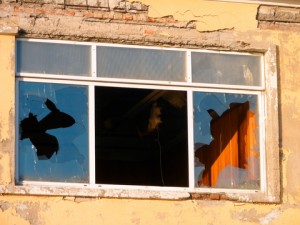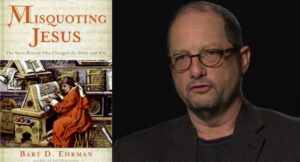In an 1982 article, James Q. Wilson and George L. Kelling announced their “broken windows” theory of crime:
Broken windows theory is a criminological theory of the normsetting and signalling effects of urban disorder and vandalism on additional crime and anti-social behavior. The theory states that monitoring and maintaining urban environments in a well-ordered condition may prevent further vandalism as well as an escalation into more serious crime.
Here’s more from Wikipedia:
Consider a building with a few broken windows. If the windows are not repaired, the tendency is for vandals to break a few more windows. Eventually, they may even break into the building, and if it’s unoccupied, perhaps become squatters or light fires inside.
Or consider a sidewalk. Some litter accumulates. Soon, more litter accumulates. Eventually, people even start leaving bags of trash from take-out restaurants there or breaking into cars.

Now consider that the oftentimes boorish, belligerent, ignorant, war-mongering people who host AM radio shows constitute the main windows of information for many Americans. I suspect that many Americans hone their method of interacting with other Americans based on the existence of AM radio shows. The existence of these many shows signals to Americans that it is OK to act like the people on the AM radio shows, to yell like them, belittle others like them, act bigoted like them, and be proudly ignorant like them. These shows serve as proxies for what is acceptable out in the real world.
I’ll end with one more quote about the theory of the broken windows theory of crime (also from Wikipedia):
A major factor in determining individual behavior is social norms, internalized rules about the appropriate way to act in a certain situation. Humans constantly monitor other people and their environment in order to determine what the correct norms for the given situation are. They also monitor others to make sure that the others act in an acceptable way. In other words, people do as others do and the group makes sure that the rules are followed. But when there are no people around, as is often the case in an anonymous urban environment, the monitoring of or by others does not work. In such an environment, criminals are much more likely to get away with robberies, thefts and vandalism. When there are no or few people around, individuals are forced to look for other clues—called signals—as to what the social norms allow them to do and how great the risk of getting caught is. An ordered and clean environment sends the signal that this is a place which is monitored, people here conform to the common norms of non-criminal behavior. A disordered environment which is littered, vandalized and not maintained sends the opposite signal: this is a place where people do as they please and where they get away with that, without being detected. As people tend to act the way they think others act, they are more likely to act “disorderly” in the disordered environment.



Broken windows, neighborhoods with lots of broken windows send behavioral messages to those who live in the neighborhood and those who come to visit. Connecting this reality to the 24/7 "… boorish, belligerent, ignorant, war-mongering …" Broken-window AM radio milieu makes for an easily grasped, very effective metaphor for this segment of contemporary American political culture. Thank you for the idea and the analogy!
Thanks, Rich. I wrote the post after deciding to scan from one side of the AM "dial" to the other while driving. Two things occurred to me: A) That the spectrum was loaded with dysfunction. I was massively embarrassed at the content of the shows, as well as many of the types of commercials being run; B) I know that many people are similarly disgusted, but they have retreated into silence, just like residents of a dysfunctional city retreat into their homes as the city decays around them, the broken windows being a symptom.
In the case of media, how do you get the functional people to come back out and participate? "Media reform" is the general principle, but the devil is in the details.